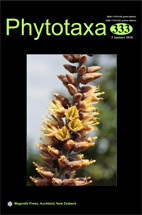Abstract
Four specimens of Stigeoclonium spp., sampled in China between 2015 and 2016, were identified as the species Stigeoclonium polyrhizum (Chaetophoraceae, Chaetophorales) due to their unique morphology. A large part of the main filament and branches was tightly enclosed by numerous rhizoidal branches, which extended downward to the base of the plant to form an expanded holdfast. S. polyrhizum has previously been regarded as a synonym of S. longipilum or other related species by most phycologists. Therefore, a reassessment of S. polyrhizum based on morphological and molecular data was conducted. Rhizoidal branch development of S. polyrhizum was also described, showing the abundant rhizoidal branches present from the juvenile stage to the mature stage under controlled culture conditions. Phylogenetic evidence, using nuclear-encoded SSU rDNA data, clearly revealed that the Chaetophoraceae diverged into two well-supported sister clades: the Chaetophora-clade and the Fritschiella-clade. S. polyrhizum was included in the Fritschiella-clade instead of the Chaetophora-clade where Chaetophora draparnaldioides (S. longipilum) was found. The morphological and molecular data unambiguously show that S. polyrhizum is a valid species rather than a synonym of S. longipilum or other related species. Thylakoid bands appressed to the periphery of the pyrenoid matrix of S. polyrhizum was also described.

